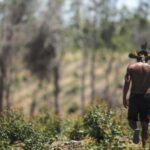You’ve probably been inundated with news from COP26, which just wrapped up over the weekend. I couldn’t keep up with the commitments, pledges, announcements, protests, and so on that happened in Glasgow over the past couple of weeks. Though aware that I’m likely contributing to your tired eyes on this topic, I couldn’t let it pass without providing my thoughts on what the most recent COP could mean for forest landscapes in the tropics.

Filling the funding gap in a way that is available and accessible
Though there has been a marked increase in financing that targets decarbonization, green growth and nature-based solutions to come out of the COP process, it has been widely acknowledged that it is not enough. In the COP 26 in Glasgow that wrapped up over the weekend, governments acknowledged that there is still a need to scale up climate finance from all sources, indicating we are not yet on track to deliver the $100 billion/year in financial flows targeted to align with the Paris Agreement and UN Sustainable Development Goals (UK COP26). An additional caveat to rectify this already grandiose shortcoming, is to ensure that earmarked funds are both predictable and accessible. I believe that a significant downside of public and multi-lateral climate finance (at least in the forestry space) is that it has been extremely inaccessible, requiring unrealistically stringent administrative systems, years of process, and (at risk of sounding like Greta Thunberg), blah blah blah, before that funding can be put into action.
Now I’m not saying that governments or companies should go out and cut cheques for multi-millions of dollars on a whim, but what I am saying – is that there must be a more efficient way, and my hope is that this is starting to surface in very focused financing mechanisms. Strategies, where the objectives of the capital, the requirements for its expenditure and even pipeline development has happened prior to announcing that certain pockets of climate finance are “available”. My hope is that the pledges that have been made this year have considered, not just lofty high-level objectives for mitigation, transition, and adaptation finance, but that they are specific in how funds will be allocated for real change, making the process much for efficient for everyone involved, including the climate! Below are a few examples of some of the pledges that have been made at COP 26.
Public funding
1. Adaptation finance
As the evidence of inevitable catastrophic climate change events are mounting, the call for more adaptation finance was also heard loud and clear. Many joined the recently convened Champions Group on Adaptation Finance, where Italy, New Zealand, Australia and the African Development Bank have joined Ireland, the Netherlands, Sweden, Denmark, the UK and Germany in championing adaptation finance solutions (iied). Furthermore, an Adaptation fund has raised a record $356 million in new pledges for concrete actions to the most vulnerable, including first time contributions from the US, Canada and Qatar (unfccc). Stand-by to see what these concrete actions will be…
2. Supporting Indigenous peoples’ forest stewardship
The rights of Indigenous peoples and their key role in sustainably managing and protecting forests was also in the spotlight at COP 26, gaining recognition by way of pledges for finance to support indigenous forest stewardship. In the COP 26 IPLC Forest Tenure Joint Donor Statement, Germany, Norway, the Netherlands, the UK, and the US as well as several foundations and NGOs pledged $1.7 billion through 2025 to finance:
- Capacity building and financial support for group activities, governance structures and management systems and sustainable livelihoods,
- Activities to secure, strengthen and protect Indigenous Peoples’ and local communities’ land and resource rights.
Now, we’re starting to see some focus – Indigenous support, capacity building, implementing activities, tenure security. This is sounding a bit closer to action on the ground.
Private funding
In the private sector, I have been inspired by two very relevant and forest-focused financing windows in Africa that were launched at COP 26:
1. The Restore Africa Programme
The Restore Africa Programme is the result of a partnership between Climate Asset Management and the Global EverGreening Alliance. The programme aims to restore more than two million hectares of land and directly support two million smallholder farms in the next five years across six African countries – Kenya, Ethiopia, Malawi, Tanzania, Uganda, and Zambia.
In this community-led approach, the Global EverGreening Alliance will support smallholder farmers on over more than two million farms to adopt regenerative and other sustainable land management practices that sequester GHG emissions at scale. Climate Asset Management intends to provide the financing required to implement these activities, against the forward volume of carbon credits expected to be produced. Under the model, investors in Climate Asset Management’s Nature Based Carbon Strategy would receive the carbon credits generated as their return (HSBC).
2. CDC Group, Finnfund and Norfund Partnership with New Forests
Development finance institutions, CDC, Finnfund and Norfund together with forest investment manager, New forests, have announced their intention to partner in a $500 million new investment fund that will raise and invest capital into sustainable forestry in Sub-Saharan Africa. This is an important joining of investors familiar with the African landscape and a globally proven sustainable forest investment manager where they aim to:
- Support the development and effective management of sustainable forestry practices, including conservation of remaining natural forests,
- Responsibly expand productive forest plantations, community forests and forest restoration projects across the region,
- Facilitate development of nature-based climate solutions that will help prevent forest loss and preserve Africa’s natural capital,
- Accelerate the creation of green jobs, improve livelihoods, and generate sustainable and inclusive economic development in rural communities across sub-Saharan Africa (CDC).
These strategies are specific in their objectives, and their investment criteria. They have implementing partners in place and compared to a lot of public pledges – are more or less ready to hit the ground running.
Clarity on Article 6
Carbon market stakeholders have been awaiting certainty on how to operationalize Article 6 of the Paris Agreement, which sets out the conditions for cross-border collaboration with respect to the setting of Nationally Determined Contributions (NDCs) and the ability to offset emissions in foreign countries at the jurisdictional and corporate level. After six years of uncertainty, countries and private sector players will now have confidence that they can develop cross-border ER strategies without fear of double-counting of emission reductions.
Ecosystem marketplace notes that the final rules agreed at COP 26 resolves confusion associated with paragraphs 2 – bilateral carbon trade, and 4 – a centralized hub that replaces the Kyoto Protocol’s Clean Development Mechanism (CDM). The Financial Times explains these rules succinctly: With respect to bilateral carbon trade, a two-part framework creates i.) a centralized system, open to the public and private sectors, and ii.) a bilateral system to allow for cross-border emission removals trading. In transactions outside of the bilateral system, the rules will require project developers to reserve 5% of credits generated by a project into a fund to support climate change adaptation in developing countries in addition to a monetary contribution. Another 2% of credits will be cancelled to support reducing emissions rather than simply balancing emissions. With regards to the replacement of the CDM, an estimated 300 million tonnes of old credits will be rolled into the new system. There is criticism that many of these credits created under the Kyoto protocol are poor quality and may flood the market with cheap units, depressing prices.
Personally, I think that old, cheap credits are in essence a different product, and the market will see them that way – it already does, so I am not so concerned with this. I believe the Article 6 rulebook is a positive step that facilitates the continuation of both bilateral emissions trading and voluntary carbon markets, enabling the flow of very critical decarbonization transition funding.
Spotlight on the end of deforestation
One of the most significant pledges to come out of COP 26, drawing the attention of mainstream media, was the pledge by nearly 150 states to stop and reverse forest loss and land degradation by 2030, backed by $12 billion in public and 7.2 billion in private funding. More than 30 financial institutions (with more than $8.7 trillion in global assets) also came on board, committing to rid investment activities linked to deforestation (UNFCCC). This is a commitment of mammoth proportions, and though it is well intended, it is bringing about a lot of criticism regarding where sustainable forest management fits into this. Furthermore, not to say it is impossible – but it is going to be quite the task to rid the world of illegal and informal forest clearing in nine years, when we’ve already been trying for decades. Sure, the large corporates with deforestation exposed supply chains will be easy targets, but what about all the small-hold subsistence farmers, or illegal loggers gradually degrading the landscape? This is probably one of the outcomes of COP 26 that I am the most skeptical about. Its not to say I don’t think it is a valiant commitment, but it is going to take quite some effort to achieve. It will take multiple approaches as there are so many complex drivers of deforestation and forest degradation that differ from region to region. And again, the billions of dollars earmarked to support this must be predictable, accessible and be linked to clear implementation strategies.
Prognosis for COP 26 commitments reaching forest landscapes in the tropics
There is no shortage of criticism regarding the effectiveness of the annual Climate COP, I’ve also shared my own! However, since the first one I attended, COP 15 in Copenhagen back in 2009, I do believe there has been steady progress, and it is picking up pace.
Forest landscapes in the tropics have been identified both as vulnerable ecosystems in need of protection, and as an opportunity for green investment (high productivity restoration that can also remove emissions, while creating significant co-benefits). In line with my key takeaways from COP 26, these are the opportunities I see coming out of COP26:
- More funding, from private and public sources is becoming available – both in terms of green growth investment, and in terms of carbon markets.
- Critical segments of the forestry value chain which have largely been unbankable, such as forest restoration in the tropics, can more easily access funding because of carbon markets, which are becoming stronger with every year that passes. This is complemented by net-zero strategies seeking high quality, impactful projects with co-benefits.
- Double counting risks are overcome and compensation for cross-boundary offset schemes are built-in, removing the guesswork of participation in carbon markets.
- The scope of emerging financing mechanisms is diversifying, allowing for the financing of a variety of nature-based solutions with a multitude of niche strategies emerging,
- Participation of indigenous and local populations in implementing nature-based solutions, especially those that can demonstrate reversal of land degradation will become increasingly attractive,
- Nature-based solutions that not only address climate change mitigation, but also adaptation – such as capacity building and livelihood diversification to support climate change resilience of local people will start to become status quo.
I remain optimistic with the COP system. As with many things, the expression “don’t let the perfect be the enemy of the good” strongly applies. I believe we are heading in the right direction; I just hope we can hit the accelerator (on a renewably powered electric car of course) and make the progress we need in time to stay on a 1.5-degree path. If you’d like to discuss how you can achieve your organization’s climate ambitions with nature-based solutions in forest landscapes in the tropics, please reach out.





